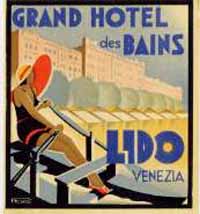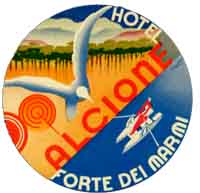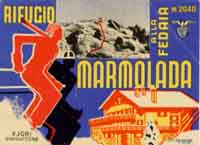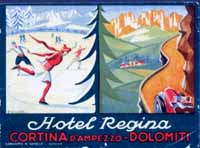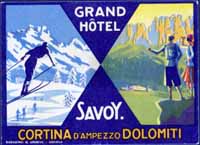| |
|
|
|
|
HOTEL
LABEL ARTISTS # 3
ITALIAN
DECO ILLUSTRATOR FILIPPO ROMOLI
by
Joao-Manuel Mimoso
|
| |
|
|
|
|
|
| In Italy, Art Deco was
influenced by local artistic and ideological trends that resulted
in a distinctive national graphic style. This is sometimes called
Futurism graphics, from the name of a movement which defended an aesthetic
based in the break with tradition and the emulation of speed. Although
Futurism in its purest, rather anarchic form, declined in the 1920s,
its influence is noticeable in many later posters and labels that
strive to give a sense of change and the transient. This was done,
either by the use of symbols of speed like cars and planes, by the
airbrushing of colors into white, or else by the use of a number of
discordant, often hand-drawn and irregular, typefaces. |
|
|
| |
|
|
|
|
|
| Such graphics were not
universally acclaimed and many clients ordering hotel labels, posters
or prospects must have squarely specified that they wanted their commissions
designed in the 'old style'. Richter, for instance, very rarely issued
labels in the deco graphic style. The Genovese printer Barabino &
Graeve (later renamed "Saiga"), on the other side, used Futurism Deco
graphics to great effect. One of its best artists was Filippo Romoli.
|
|
|
| |
|
|
|
|
|
| Romoli was born in 1901
in Savona. In 1919 he moved to Genoa with his family and eventually
found work as draugthsman with a local manufacturer of electrical
machinery, while doing artistic work as a freelancer. In 1926 he started
doing publicity graphics for Barabino & Graeve. He designed many posters,
folders and other similar paper graphics. He also did a number of
hotel labels, in the Deco style, which he fortunately signed. After
the war he diversified into other fields of artistic creativity, working
almost until his death in 1969, but is best remembered for his Deco
posters of the late 1920s and 1930s. |
|
|
| |
|
|
|
|
|
| Although Romoli was an
efficient designer and left some remarkable hotel labels (three of
his best: Hotel des Bains, Corno d'Oro Hotel, and Hotel Alcione are
included in this page) he was not influential in the same sense as
Richter's artists were. Actually he does not show a coherent, distinctive
style as can be asserted through the many different designs in this
page several of which are only identified as his by the signature
"F. Romoli". Also he did not fall on an aesthetic desert-like
environment to which he might become a bearer of color and style as,
in a manner, Mario Borgoni once had been. Romoli was a good artist
but only one of a large pleiad of gifted designers that were the source
of the great Italian graphics of the 1920s and 30s. |
|
|
|
|
|
|
Lisbon, Portugal
Apr.2003
|
| hotel
label index |
|
|
|
| my
home-page |
Visit
a page with Romoli posters and a picture of the artist |
|
